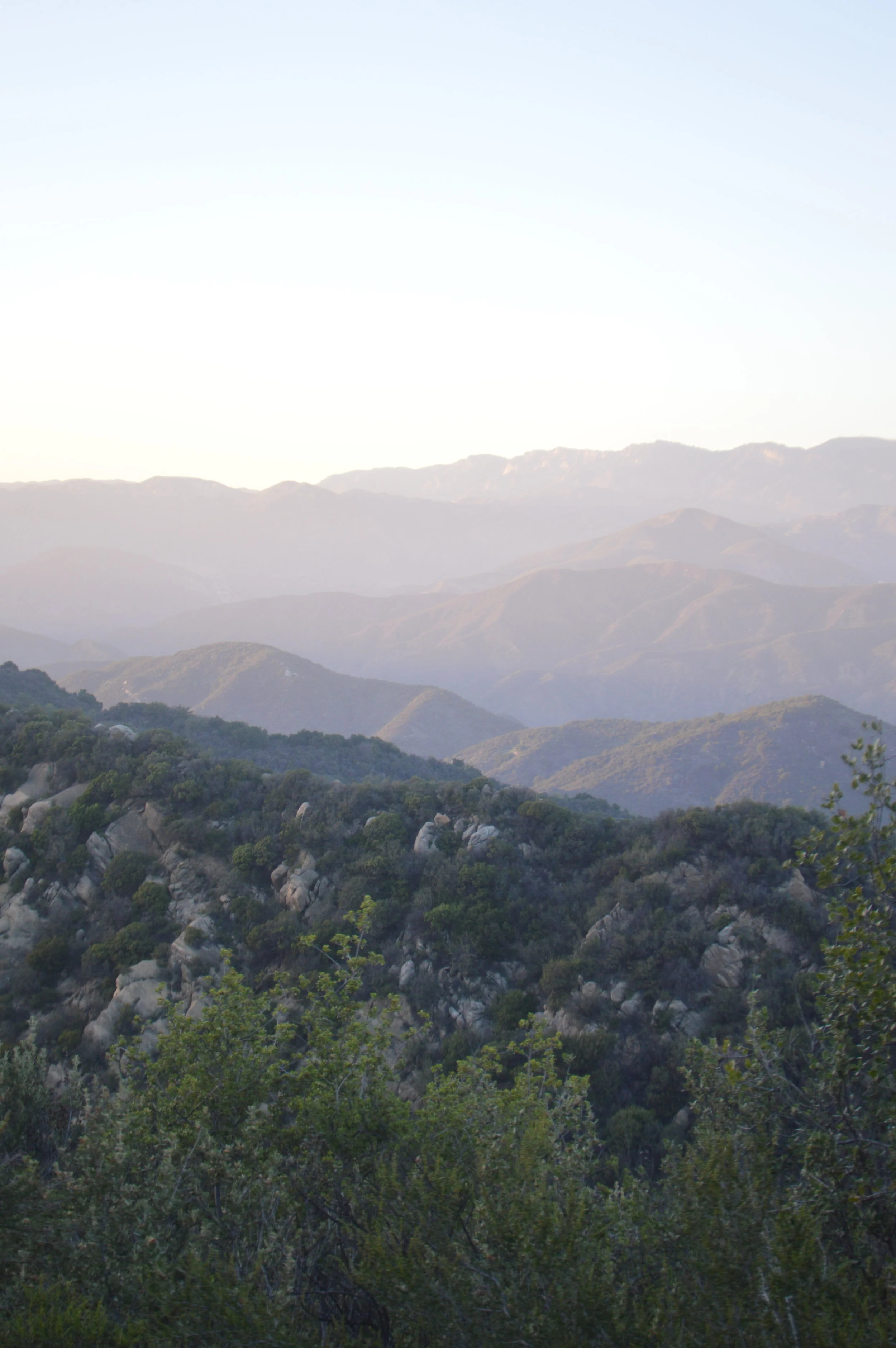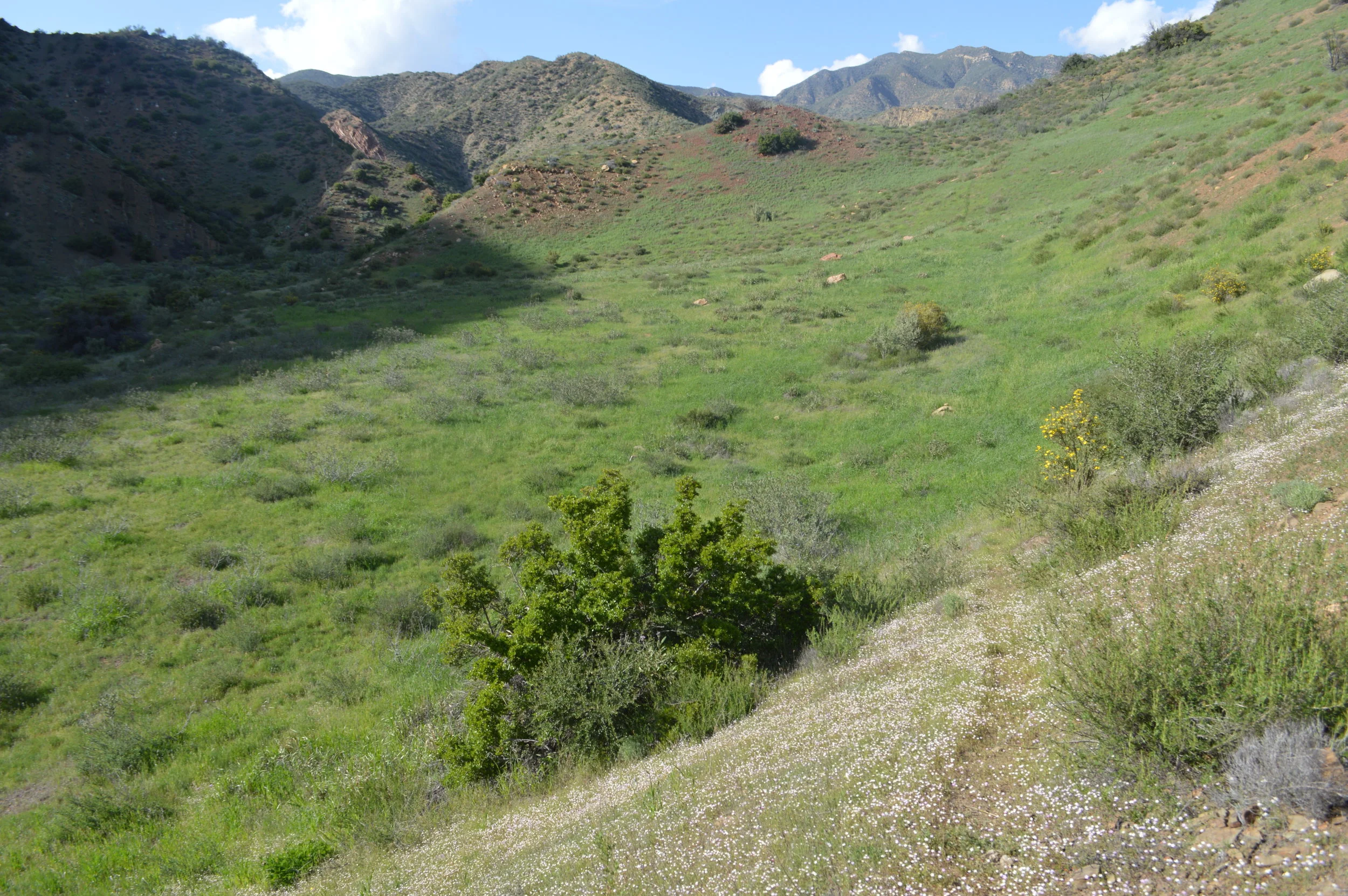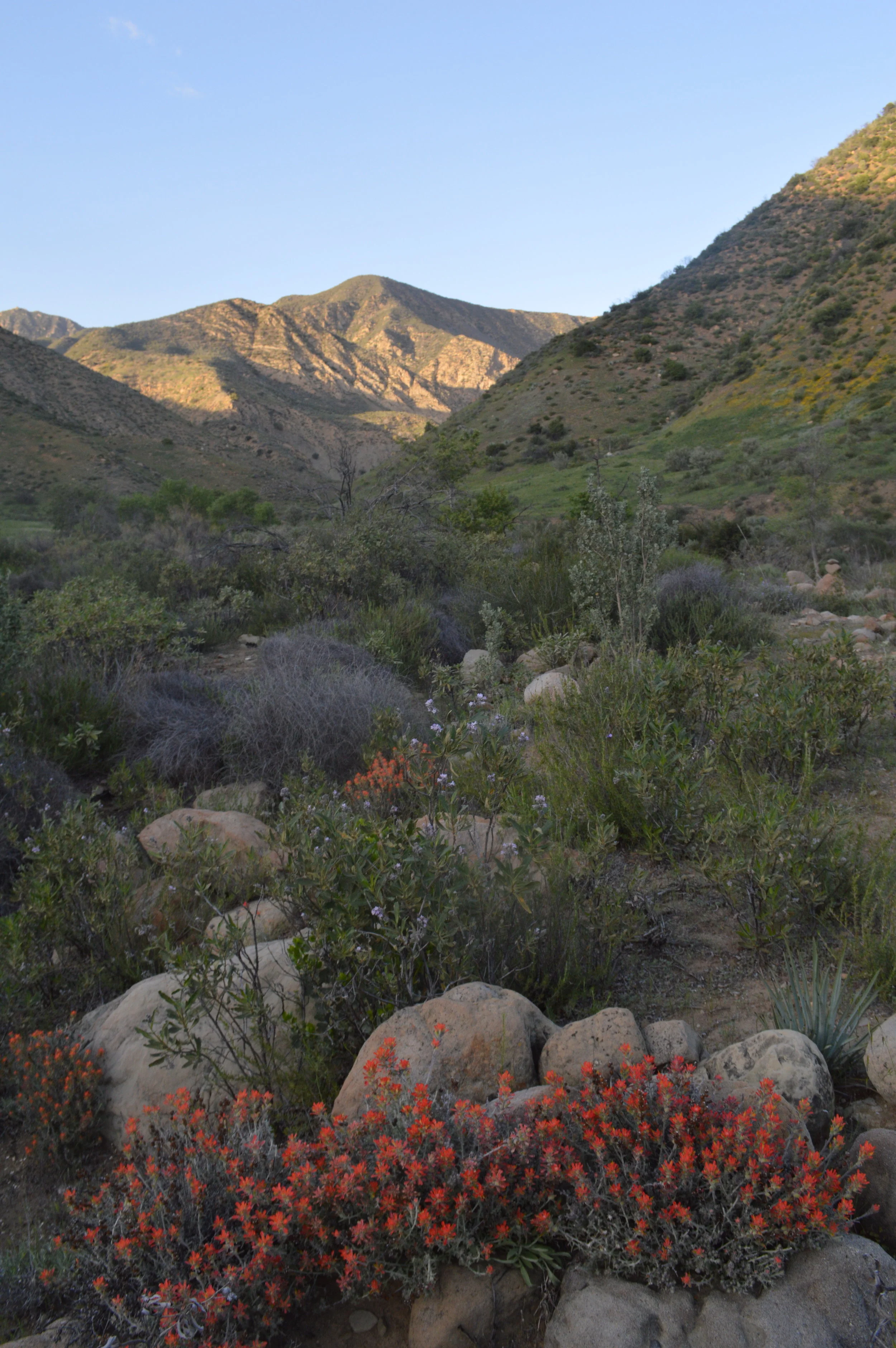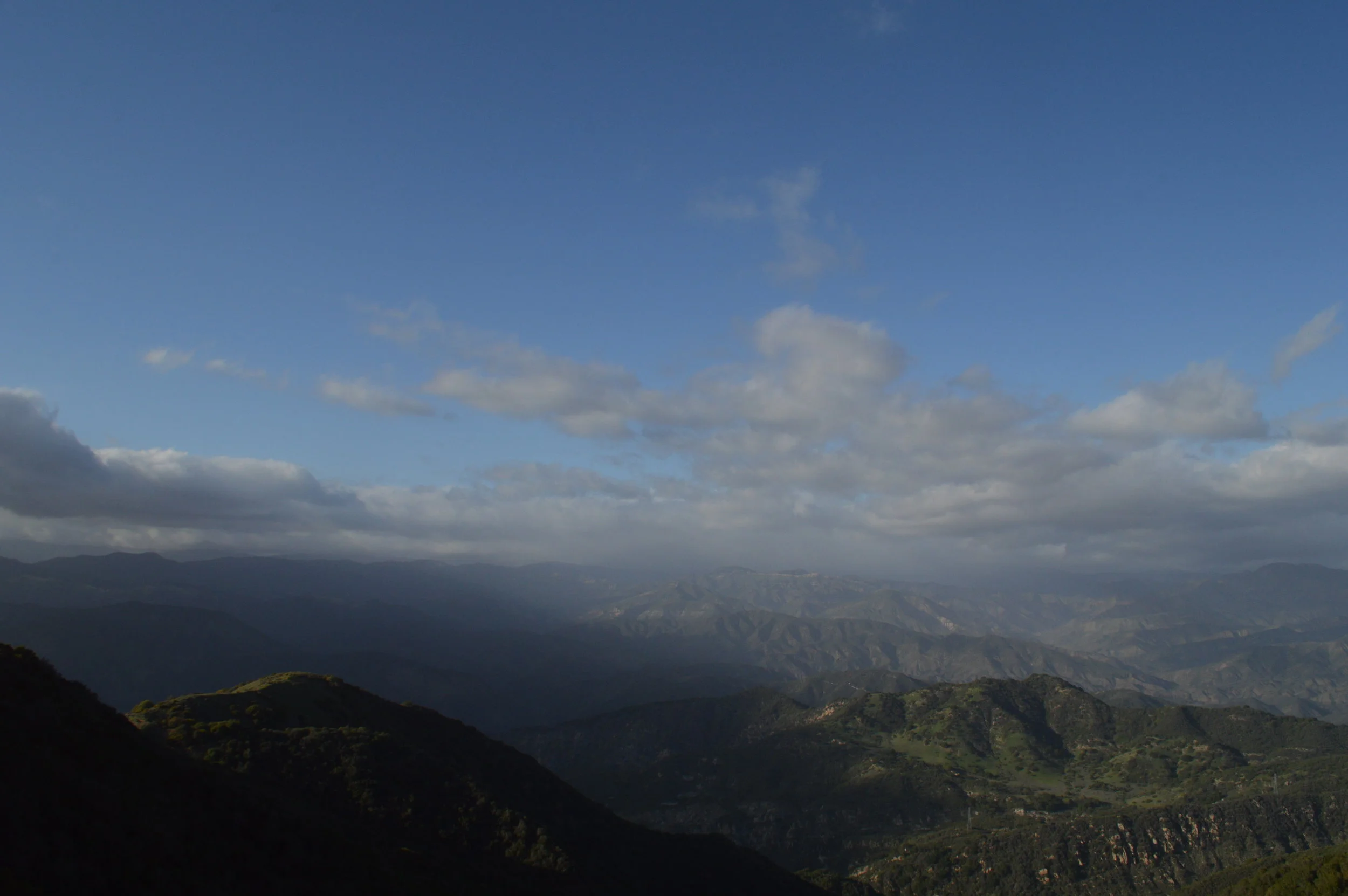East Camino Cielo to Upper Caliente Canyon
Originally published April 11, 2016 in the Santa Barbara Independent
NOTE: This route is for serious and practiced adventurers only. Barring any major rain events this spring, the following route from East Camino Cielo to Upper Agua Caliente Canyon will likely only be doable for another month or two until next winter or spring. Water sources are intermittent and increasingly unreliable as the summer nears. Due to a barely discernible trail, only those with navigational skills and outdoor experience should visit Upper Caliente, even if arriving to the trailhead by car.
The Big Caliente Hot Springs are one of the most popular destinations in our backcountry, but hardly anyone ventures past to see the canyon from which their neighboring creek flows. Those few who do will witness an almost untrammeled land, one vibrant with massive meadowlands and chaotic red rock. Though technically not even wilderness — the canyon is wedged between, but never enters, the Dick Smith and Matilija Wilderness areas — there are few places in Santa Barbara County accessible within a day that feel this wild, remote, or special.
Though one can drive to the trailhead, the road is often closed or rugged due to weather. A much more adventurous option is there for those willing to put in the miles and willing to risk a lack of water. Leaving from East Camino Cielo, this route descends from the top of the Santa Ynez Mountains into the vast expanses of Blue Canyon and the Mid-Santa Ynez area before traveling up into the wide and rugged drainage known as Agua Caliente. The route is about 10 miles from East Camino Cielo to Upper Caliente Camp (9.9 by map measurements), including almost 2,000 feet of descent in the first 2.6 miles (1,876 feet to be exact), which will be regained on the way out.
The trek begins at Cold Springs Saddle, where one heads downward first to Forbush Flats (1.7 miles in). From up here, one can already see the red hues of Agua Caliente perking up between the purplish folds of foothills fanning out in front of you. Continue ever-downward through whispering oaks until you arrive at the big meadows of Cottam Camp (2.6 miles in). If you can make it a two-night trek, this a great place to stay for the first leg of your journey. Flowing water is more abundant here than anywhere else up ahead.
From here, the trail crosses into the flatlands that merge Blue Canyon with the wider river valley of the Santa Ynez. The path meanders across wide rock-strewn banks, where a colorful scattering of serpentine and schist spread out underneath you. The trail itself can be slightly easy to lose, but not the way — just keep heading north. You pass the Santa Ynez River, or rather riverbed, which was even by end of March completely dry in large patches. Around here, the forests are quiet, grassy, and undisturbed, resting in a seldom-visited slice in between areas with more frequent recreation.
You arrive next at Romero-Camuesa Road, where the occasional jeep rolls by. Here, the road is dusty, dry, and slightly disheartening, being away from any water source and with infrequent shade. The bodies of toads lay squashed and sun-dried along the way, a bit of natural selection via 4WD. A good rest stop or another first-night sleeping option would be one of two drive-in campgrounds, P-Bar Flat at 4.8 miles in, or Middle Santa Ynez at 5.9.
The next reliably flowing water after Cottam Camp and the stretch of creek thereafter could be found at dripping Pendola Debris Dam. Constructed to prevent runoff from silting Gibraltar Reservoir, this and Agua Caliente Dam a couple further miles up now stand as both sad and funny relics to more watery times. Traveling here by foot instead of car allows you ample time to appreciate the surprisingly beautiful geology of the canyon’s wide mouth as cars kick up dust nearby. Continue two miles up the road until you reach the Big Caliente Hot Springs, a more-than-welcome relaxation point and where most journeys to this area end.
If you can wrest yourself from the loving arms of Big Caliente, then you will be treated in the next two miles with the beautiful rarity of seldom-seen Upper Caliente. Agua Caliente Debris Dam guards this relatively untouched section of riparian land, a pathetic pool kneeling at its dry walls. Beyond, the trail disappears into a forest rich with grassy undergrowth and sprawling sycamores and oaks. Though level, I hesitate to describe it as “easy” in the usual sense — this is not a place for those who need a trail to travel.
Passing this grassy forest, the route opens up to reveal the sprawling meadowlands that characterize Upper Caliente. The gateway to this wonderland is an idyllic rock-bound swimming pool known as The Oasis, just over a mile from the trailhead. Though once deeper, the pool is true to its name in otherwise thirsty Agua Caliente Canyon, through which an alternatingly trickling and terminating creek lightly travels. Bear and mountain lion footprints — not humans’ — are the only footsteps to mark the land.
Upper Caliente Camp itself is mounted on a meadow-topped island in the divide between Agua Caliente Creek and a minor tributary. It’s surprisingly hard to find, but it’s there. From here, the canyon continues up, with another two miles available for further exploration. Each new bend in the canyon hides a new meadow, and each meadow bound by towering rock walls and side canyons leading into the unknown. Those who appreciate the beauty of our local geology will find in Agua Caliente a treasure trove of scenic cliffs and crags. In spring, Agua Caliente Canyon is the quintessence of the season, exploding with vibrant colors and alive with wildlife. Here, arroyo toads bounce fat and happy, not smashed and dead. When night falls on Agua Caliente, it is like being in a stadium with wildlife in the seats and you at the center — all around you ring the almost deafening din of nighttime songs.
Exit the way you came. The final 2.6 miles are all uphill, almost 2,000 feet of ascent. It’s a push, particularly since you have already traveled many miles to get here. Pace yourself, and plan your water accordingly. When you finally peak out at East Camino Cielo again, with the city down below you and the canyon beyond you, you are awarded the unique sensation of having earned a deeper understanding of not just the backcountry, but the mid- and fore-countries leading to it. Even though anyone can see the land from East Camino Cielo, you will now be one of the very few to appreciate the secrets of Upper Caliente and the lands between and beyond.




